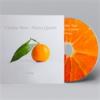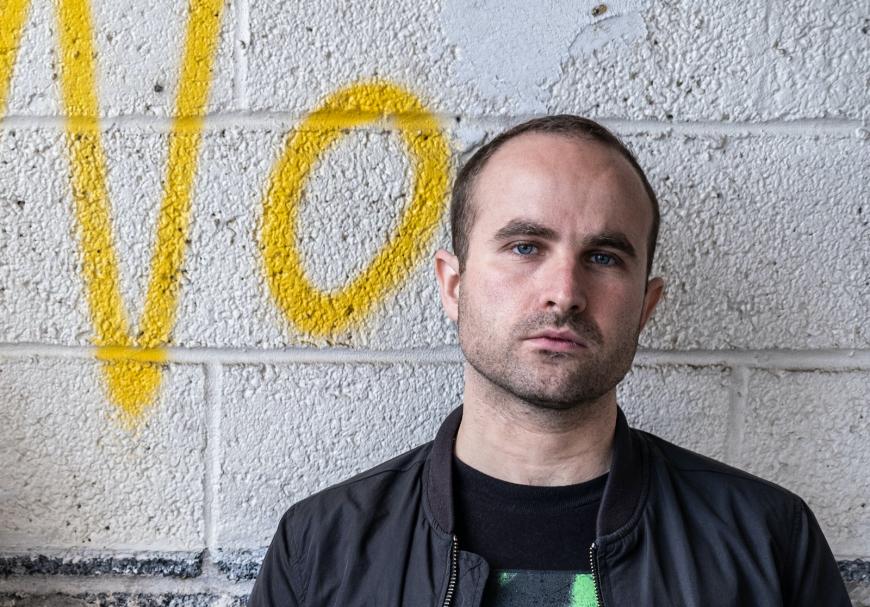
Artists often innovate by evolving a connection between existing genres. That’s a risky business, however, as three recent albums show. All of them sent flares up over the borderlands between contemporary classical music and the rest of the musical world. While this is not an unusual occurrence, these albums piqued my interest for both their fumbles and their successes. They are emblematic of the rocky history of cross-genre work involving musicians of classical background — a history of inventiveness, good intentions, and bad oversights.

In June, crossover contemporary-metal group Real Loud released their eponymous first album, featuring four pieces by Pascal Le Boeuf, Paul Kerekes, Jenny Beck, and Brendon Randall-Myers, who is the only composer who is also part of the band.
Many classically trained musicians and composers want to be involved in music outside of notated concert music simply because most musicians love a lot of different music. And as people from this “classical” side find their ways to become involved in “popular” genres, calling this new music “contemporary classical” feels less and less fitting. It is equally hard to tell if the boundary is being pushed from the classical side to contain new hybridizations — claiming space within another genre or practice — or if the salt circle is truly being smudged or rubbed out entirely.
Within certain genres, however, the tidal interaction between notating composers and popular composers seems easier and more productive, and metal/progressive rock is one of those genres. When you look at the big picture of musical values between heavy metal and the second half of 20th century classical music, individual virtuosity (and velocity), overarching concepts to longer pieces, an aversion to levity, and an interest in exploring the boundary of music and noise are areas of overlap between metal and contemporary classical music. It’s not a big surprise to find out that Frank Zappa was a huge Edgard Varèse fan or that “New York-based antiphonal chamber metal band” Real Loud exists, and that their first album manages to not feel caught between two genres. I happily headbanged to Brendon Randall-Myers’s 15-minute epic Double-Double.
Even in the more floaty and spatial tracks by Jenny Beck and Paul Kerekes — both focusing on the audio play between left and right speakers, both invested in texture and sustain — there is precedent for this kind of work in the sphere of Fluxus, Lou Reed, and Sonic Youth. While Beck’s dock of ghost ships Go in Secret and the BMX bike with no brakes that is Le Boeuf’s Forbidden Subjects would seem to be placed in vastly separated music cultures, they really are punk house roommates, both now and historically.
Real Loud doesn’t suffer from the awkwardness that cross-genre projects often do because it’s simply not crossing genre in any vital way. It’s basically a Progressive Metal album. It was probably easy for these highly trained and versatile players — Tristan Kasten-Krause and Evan Runyon on bass guitar, James Moore and Brendon Randall-Myers on electric guitar, and Mark Sauer-Utley and Clara Warnaar on drums — to find each other.
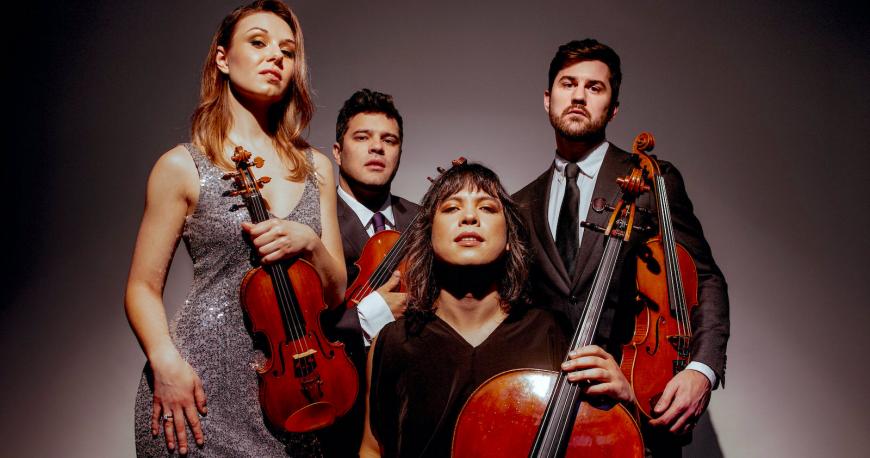
In contrast, EDM (electronic dance music) does not have the same history of robust exchange as classical and Metal, making Attacca Quartet’s July album Real Life a stilted cross-genre effort. Real Life is a collection of covers of EDM artists such as Flying Lotus, Halluci Nation, Anne Müller, and Louis Cole, as well as two new pieces written in collaboration with Daedalus and Squarepusher. I wish the whole album had been new works made from the ground up with these artists, I wish Attacca hadn’t insisted on being the central focus; it did a disservice to the pieces they like so much simply because they seemed to overlook integral aspects of what makes this electronically produced music so enthralling. But let’s take a step back.
Music in which groove is a central element — like EDM’s ancestor, disco, and its sibling, hip-hop — has always ended up being wildly popular but underappreciated in the academic music sphere. Even in my own experience, showing groove-based music I like to my composition professors, I would be met with comments like, “This sounds cool, but I just think it’s too repetitive,” or “Couldn’t she have cut the percussion for a bit?” or “Now, think about if they had changed the meter at some point.” Metal, having independently incorporated mixed meter and changing meter into the music, is much more acceptable to classically trained composers.

The difference here between the acceptability of the manipulations of meter and beat in metal and the brushing-off of groove in other genres is easily explainable by the racial lines drawn between those genres. Even the establishment of the terms “popular” and “classic” in the U.S. can be tied to attempts to separate music made by Black people from the kind of intellectual consideration and value of white European music. Those classically trained composers who want to create in a groove-based idiom have a lot of culturally received hurdles to jump; systemic racism has resulted in far fewer adventures into the area between classical and EDM.
Exceptions exist — Laurie Anderson, Pamela Z, J Lin come to mind — but often the engagement comes down to something like Phillip Glass’s David Bowie symphonies, orchestra backed performances of early Detroit Techno artists Jeff Mills and Carl Craig, or an orchestration of rave/club music by Thomas Adès. These are examples of a translational approach, where sounds of another music are passed through the value-filter of notation to make them roughly playable by classical musicians. This can be done with a range of cleverness and finesse to the orchestration, but fundamentally is it an effort to translate, rather than learning to speak in the language.
I think Attacca Quartet were trying to avoid sounding like they were only translating the EDM tracks by increasing the use of modern production techniques, but they didn’t succeed on many tracks. (Least convincing are all the tracks they had made music videos for and released as singles.) Many pieces are underwhelming, despite the distortion and the excellent force and finesse they put into the performances. It sounds like very expensive karaoke.
Perhaps part of their downfall was undervaluing the particular importance of samples in EDM. Samples — clips of prior-recorded music and sound — are used in an almost mosaic-like fashion, finding and cutting to shape the perfect chip of audio to complete a track’s overall impact. The cultural context of the sample — what recording or place it came from, what other tracks it has been used in — is considered a major factor of the listener’s musical experience.
Group Halluci Nation are known for using samples of Native American singers in their tracks and their party favorite Electric Pow Wow Drum is no exception. They set the samples of the singers in such a way that it amplifies the kinesthetic thrill of the sampled song, and, at least to my settler ears, heightens the feeling of partying and togetherness.
Hearing Attacca try to bring that energy, try to translate that vocal sound into their instruments just made me want to listen to the original. Listening back and forth between the two I was struck by the misunderstanding that seemed to be going on. Without those samples, the meaning of the joy just falls out.
For others, like the titular track Real Life by Louis Cole, simply playing the vocal line flattens it. I can see that they are trying to find a way to avoid being a string backing track for Louis Cole, but in their pursuit of new versions of these songs that they can sit center stage and play, they compromised the needs of the songs they chose.
Where the group’s fantastic skill was used to best effect was in the covers of the two instrumental Flying Lotus tracks and in the new pieces that were written for the group by Squarepusher and Daedalus. Flying Lotus, stage name of producer and rapper Steven Ellison, is an alchemical musician whose tracks glitter with complexity and grit. He often works with very organic-sounding samples and synthesizers, and as the grand-nephew of jazz piano and harp legend Alice Coltrane, he often uses samples of harp, as he does in the original Attacca covers, Clock Catchers.
But this crossover succeeds, again, because there are common musical values being accentuated here — the fantastic production and arrangements of Clock Catchers and Pilgrim Side Eye by Snarky Puppy band leader Michael League and producer Nic Hard were facilitated by the commonalities between such things as the harp samples (not that far a jump to cello pizzicato) and Flying Lotus’s brand of layered virtuosity. The sounds of the original tracks make sense to translate to string quartet, in this case.
Attacca violist Nathan Schram is quoted as saying, “I remember the first time I heard Flying Lotus’s music. It was a confusing combination of exhilaration, envy, and deep FOMO [fear of missing out]. His music is hyper-sophisticated, endlessly nuanced, and hits all the feels you didn’t know you had.” It’s a good thing that this classical musician is listening to EDM and hearing sophistication and nuance. But when their cellist Andrew Yee says, “We never think: ‘Can we do it?’ We just want to do it, and so we give ourselves the goal,” it makes you think that there was maybe a lack of critical thought about differences in genre and style. Their choice to gear these arrangements toward traditional quartet stage performances shot them in the foot, particularly in the tracks that involved crucial vocals.

Earlier this month, Apollo Chamber Players brought together pieces under the umbrella of being “globally influenced” by some kind of emphasis on folk music. The result is their new album With Malice Toward None, featuring Pamela Z, J. Kimo Williams, Christopher Theofanidis with Mark Wingate, and Eve Belgarian.
With Malice Toward None has many different approaches to the prompt “globally-inspired” music, including not responding to the prompt at all in the case of Theofanidis and Wingate; their piece cracks open Samuel Beckett’s What is the Word? Despite this variety, largely these composers’ response to “folk” music is within the realm of more standard western compositional processes.
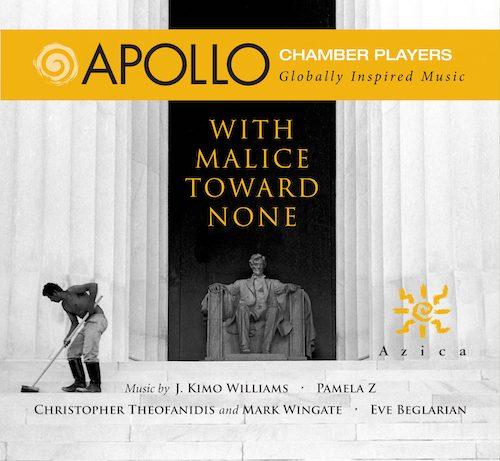
Closest to the “translational” side of the spectrum is a set folk song string arrangements by renowned Armenian composer Komitas (1891 – 1915), followed by Eve Beglarian’s We Will Sing One Song, an imagining of a scene from Armenian-American writer William Saroyan’s novel The Human Comedy. Belgarian and J. Kimo Williams both fold in music from outside the Western Classical sphere via the inclusion of particular practitioners — Arsen Petrosyan on duduk and Pejman Hadadi on Armenian percussion, and, in Williams’s titular With Malice Toward None, the electronic violin wailer Tracy Silverman.
This is probably the most common form of cross-genre concert music from the past 30 or so years — by working directly with a musician from another genre or folk tradition, composers set up a personal frame to showcase, comment on, at best exchange with, and at worst “other” another kind of music within the comfortable home grounds of concert music. Belgarian’s and Williams’s pieces feel like a versatile but united work of art: Williams gave off thorough, personal authenticity in this piece, probably due to his own long experience as a rock guitarist in the 1960s and ’70s.
Both Pamela Z and Williams drew from the folk music of their lives, largely rock and American folk music from that 1960s and ’70s era. I love their music because it simultaneously fits the brief they were given and questions the kind of boundary that the phrase “globally inspired” unwittingly erects.
Pamela Z’s music always cuts through the noise because it sounds interested. When listening to her work we are listening to the playing out of her interest in a topic, a sound, a parameter of technology, and because her interest is so clear we are interested. In The Unravelling she brings her Z magnifying glass to her history with American folk. She transforms the lonely chestnut “500 Miles,” popularized by Peter, Paul and Mary, into timeless spiraling she describes as “a broken record.” The effect is a new kind of loneliness, in a cosmic, drifting-from-the-space-shuttle kind of way. Perhaps, Z has turned her gaze to the time that has passed since she sang the song busking with her friends in San Francisco.
And maybe we hear some of the generational disappointment in the unfulfilled promises of the ’60s in her movement “Microbus.” She describes this track as “whimsical,” which doesn’t account for the sweet sadness I hear. It was her reality then, driving up and down the California coast with her friends, busking and singing “all the words,” believing “all the words,” even if it wasn’t realistic once the dust cleared.
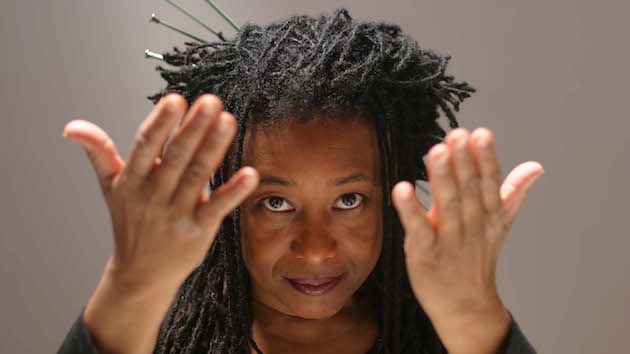
Again, looking at these albums we find these tie-downs, or maybe snags, that connect the fabric of music in the United States to the hard-fought Civil Rights movements. Maybe this has to do with the solidification of the modern recording industry (which is experiencing a reliquification at this moment) that occurred back then. But it also has to do with the effect that these post-colonial movements had on American culture, including fundamentally changing the production of music by Americans.
These three albums bear the scars of white hegemony — scars that limit fluid movement as much as they indicate historical trauma resulting from the othering of people of color and the music they have made. All three albums have much to enjoy and may serve to increase awareness of the source of such terminological distinctions as “popular” versus “classical,” “mainstream” versus “progressive” or “underground” or “experimental,” “vernacular” versus “sophisticated.” These terms along with their attachments to different genres are important, even if musicians continue to make work that blurs those boundaries as a crucial aspect in our musical evolution. It is important to not blindly subscribe to these distinctions, but it is equally important to learn and not forget why, how, and by whom the walls were built.



